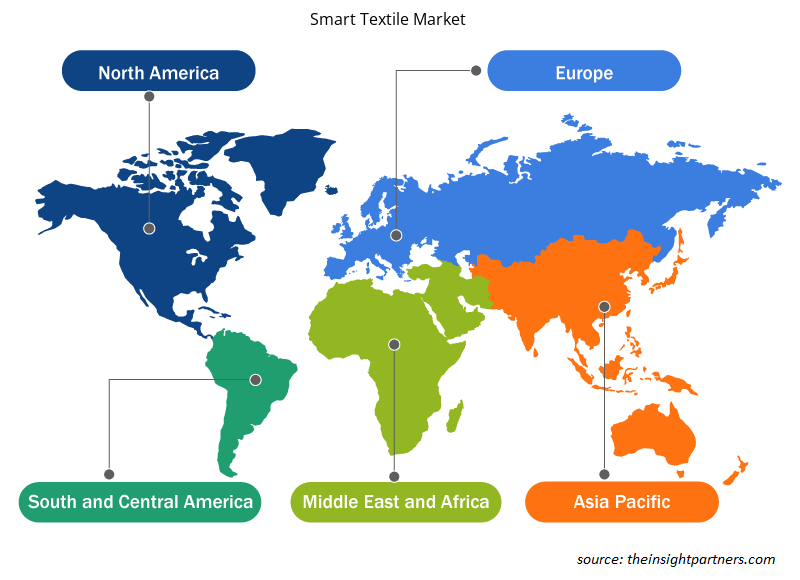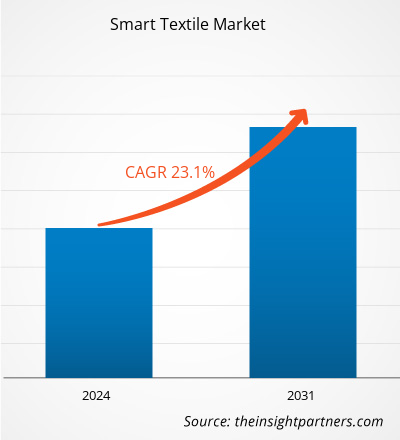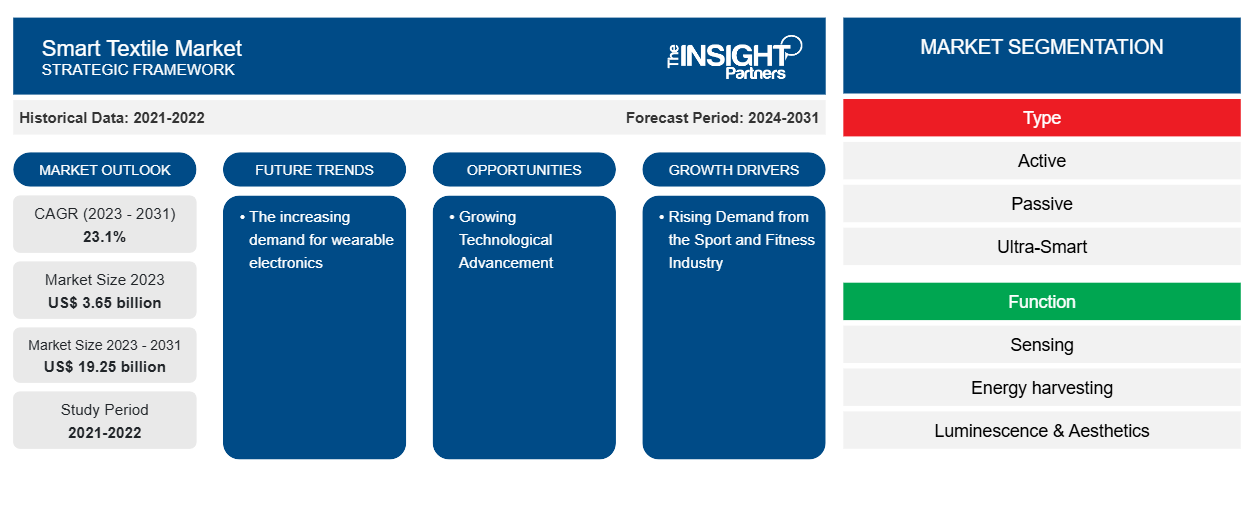智能纺织品市场规模预计将从 2023 年的 36.5 亿美元增至 2031 年的 192.5 亿美元。预计 2023-2031 年市场复合年增长率将达到 23.1%。对可穿戴电子产品的需求不断增长可能仍是智能纺织品市场的一个关键趋势。
智能纺织品市场分析
得益于智能纺织材料的进步,纺织行业发生了巨大的转变,这使得企业能够将业务范围扩大到高科技应用和传统市场之外的领域。智能纺织品是嵌入了计算能力的材料,可提供刺激、通信和监控等额外功能。由于现代电子产品的小型化趋势减弱以及对智能设备的需求不断增加,可穿戴电子行业正在扩大。纺织品中RFID、传感器技术和纳米技术的发展也刺激了市场扩张。
智能纺织品市场概览
智能纺织品是与导电纤维、微控制器和传感器等数字元素相结合的纺织品。这些纺织品具有感知、响应和适应周围环境变化或源自化学、机械或热原因的刺激的能力。与常规材料不同,智能纺织品包括可以传输数据的交互功能。它们越来越多地用于医疗保健、体育、时尚和军事行业。在医疗保健领域,它们可以监测生命体征并通知医务人员。它们能够跟踪运动中的表现参数。军事用途包括增强伪装和内置通信设备的防弹衣。
定制此报告以满足您的需求
您可以免费定制任何报告,包括本报告的部分内容、国家级分析、Excel 数据包,以及为初创企业和大学提供优惠和折扣
- 获取此报告的关键市场趋势。这个免费样品将包括数据分析,从市场趋势到估计和预测。
智能纺织品市场驱动因素和机遇
体育和健身行业的需求不断增长
健身爱好者和运动员一直在寻找提高训练效果和表现的方法。智能纺织品非常适合这种优化过程。这些纺织品包括评估步态的袜子和跟踪肌肉活动的衬衫,可提供大量数据,可用于修改训练计划和避免事故。此外,收集的数据可以与智能手机或其他设备同步,从而能够根据实时反馈立即采取行动。运动员和休闲跑步者现在都可以访问这种程度的细粒度数据收集,而这以前是专门的运动实验室独有的。此外,全球对健康和保健趋势的日益关注正在推动对运动和健身领域智能纺织品的需求,因为它们提供了一种轻松的方式来监控大量数据,这些数据有助于实现更好、更积极的生活方式。
科技进步日新月异
由于引入了人工智能 (Al) 和物联网 (IoT) 等新技术,纺织业发生了变化。人工智能、低功耗蓝牙 (BLE)、边缘计算和云数据都被整合到正在生产的新型智能服装中。这种服装可以监测和传输穿着者的数据,例如体温、心率、血压和出汗量。人工智能能够检索和收集过去和现在的运营数据,并提供可以提高穿着者生产力的见解。人工智能经常用于纺织品制造的各种目的,包括配色、图案检查和缺陷检测。此外,人工智能的整合使得生产使用电气和物联网传感器来提供出色用户体验的智能服装成为可能。因此,将技术融入纺织品可以创造更舒适、更健康的体验,预计这将为预测期内智能纺织品市场的增长创造机会。
智能纺织品市场报告细分分析
有助于得出智能纺织品市场分析的关键部分是类型、功能和行业垂直。
- 根据类型,智能纺织品市场分为主动、被动和超智能。预计主动细分市场将在预测期内增长。
- 根据功能,市场分为传感、能量收集、发光和美学以及热电。传感部分预计在预测期内增长。
- 按垂直行业划分,市场分为医疗保健、运动与健身、时尚、军事和汽车。预计运动与健身领域将在预测期内增长。
智能纺织品市场份额按地区分析
智能纺织品市场报告的地理范围主要分为五个地区:北美、亚太、欧洲、中东和非洲、南美/南美和中美。
就收入而言,北美占据了智能纺织品最大的市场份额。该地区的市场分为美国、加拿大和墨西哥。该地区市场的扩张是由政府对国防和军事工业的不断增加的投资以及强大的购买力推动的。此外,该地区很大一部分人口患有肥胖症,这是主要的健康挑战之一。因此,消费者倾向于健康的生活方式并购买能够支持他们持续身体活动的商品。因此,为了保持竞争力,市场参与者正致力于以可承受的成本提供尖端产品。此外,政府在研发计划上的支出不断增加,特别是在医疗保健行业,这进一步推动了智能纺织品市场的增长。
智能纺织品市场区域洞察
Insight Partners 的分析师已详尽解释了预测期内影响智能纺织品市场的区域趋势和因素。本节还讨论了北美、欧洲、亚太地区、中东和非洲以及南美和中美洲的智能纺织品市场细分和地理位置。

- 获取智能纺织品市场的区域特定数据
智能纺织品市场报告范围
| 报告属性 | 细节 |
|---|---|
| 2023 年的市场规模 | 36.5亿美元 |
| 2031 年市场规模 | 192.5亿美元 |
| 全球复合年增长率(2023 - 2031) | 23.1% |
| 史料 | 2021-2022 |
| 预测期 | 2024-2031 |
| 涵盖的领域 | 按类型
|
| 覆盖地区和国家 | 北美
|
| 市场领导者和主要公司简介 |
|
市场参与者密度:了解其对商业动态的影响
智能纺织品市场正在快速增长,这得益于终端用户需求的不断增长,而这些需求又源于消费者偏好的不断变化、技术进步以及对产品优势的认识不断提高等因素。随着需求的增加,企业正在扩大其产品范围,进行创新以满足消费者的需求,并利用新兴趋势,从而进一步推动市场增长。
市场参与者密度是指在特定市场或行业内运营的企业或公司的分布情况。它表明在给定市场空间中,相对于其规模或总市场价值,有多少竞争对手(市场参与者)存在。
在智能纺织品市场运营的主要公司有:
- 杜邦
- 捷普
- 感官
- 互动服装公司
- 阿迪达斯
- 六角形
免责声明:上面列出的公司没有按照任何特定顺序排列。

- 了解智能纺织品市场顶级关键参与者概况
智能纺织品市场新闻和最新发展
智能纺织品市场通过收集一手和二手研究后的定性和定量数据进行评估,其中包括重要的公司出版物、协会数据和数据库。以下是市场发展情况的列表:
- Loomia Technologies 与美国先进功能面料公司 (AFFOA) 合作开发触感极佳的加热手套,可同时适用于商业/娱乐和军事客户。对于这个合作项目,Loomia 将提供用于加热手套内衬的技术,而 AFFOA 将领导客户探索、提供系统架构设计并生产接口控制单元。除了加热手套内衬,Loomia 还将开发加热袖套。这两款产品都将为恶劣气候或其他需要这种保护的地区用户提供热舒适感。(来源:Loomia Technologies,新闻稿,2022 年)
- 英国时尚纺织协会 (UKFT) 宣布与智能纺织联盟建立合作伙伴关系。STA 和 UKFT 之间的合作将互惠互利,为技术和时尚领域的创新开辟新的途径。(来源:UKFT,新闻稿,2021 年)
智能纺织品市场报告范围和交付成果
“智能纺织品市场规模和预测(2021-2031)”报告对以下领域进行了详细的市场分析:
- 范围内所有主要细分市场的全球、区域和国家层面的市场规模和预测
- 市场动态,如驱动因素、限制因素和关键机遇
- 未来的主要趋势
- 详细的 PEST/波特五力分析和 SWOT 分析
- 全球和区域市场分析涵盖关键市场趋势、主要参与者、法规和最新市场发展
- 行业格局和竞争分析,涵盖市场集中度、热点图分析、知名参与者和最新发展
- 详细的公司简介
- 历史分析(2 年)、基准年、预测(7 年)及复合年增长率
- PEST和SWOT分析
- 市场规模、价值/数量 - 全球、区域、国家
- 行业和竞争格局
- Excel 数据集
近期报告
客户评价
购买理由
- 明智的决策
- 了解市场动态
- 竞争分析
- 客户洞察
- 市场预测
- 风险规避
- 战略规划
- 投资论证
- 识别新兴市场
- 优化营销策略
- 提升运营效率
- 顺应监管趋势





















 获取免费样品 - 智能纺织品市场
获取免费样品 - 智能纺织品市场